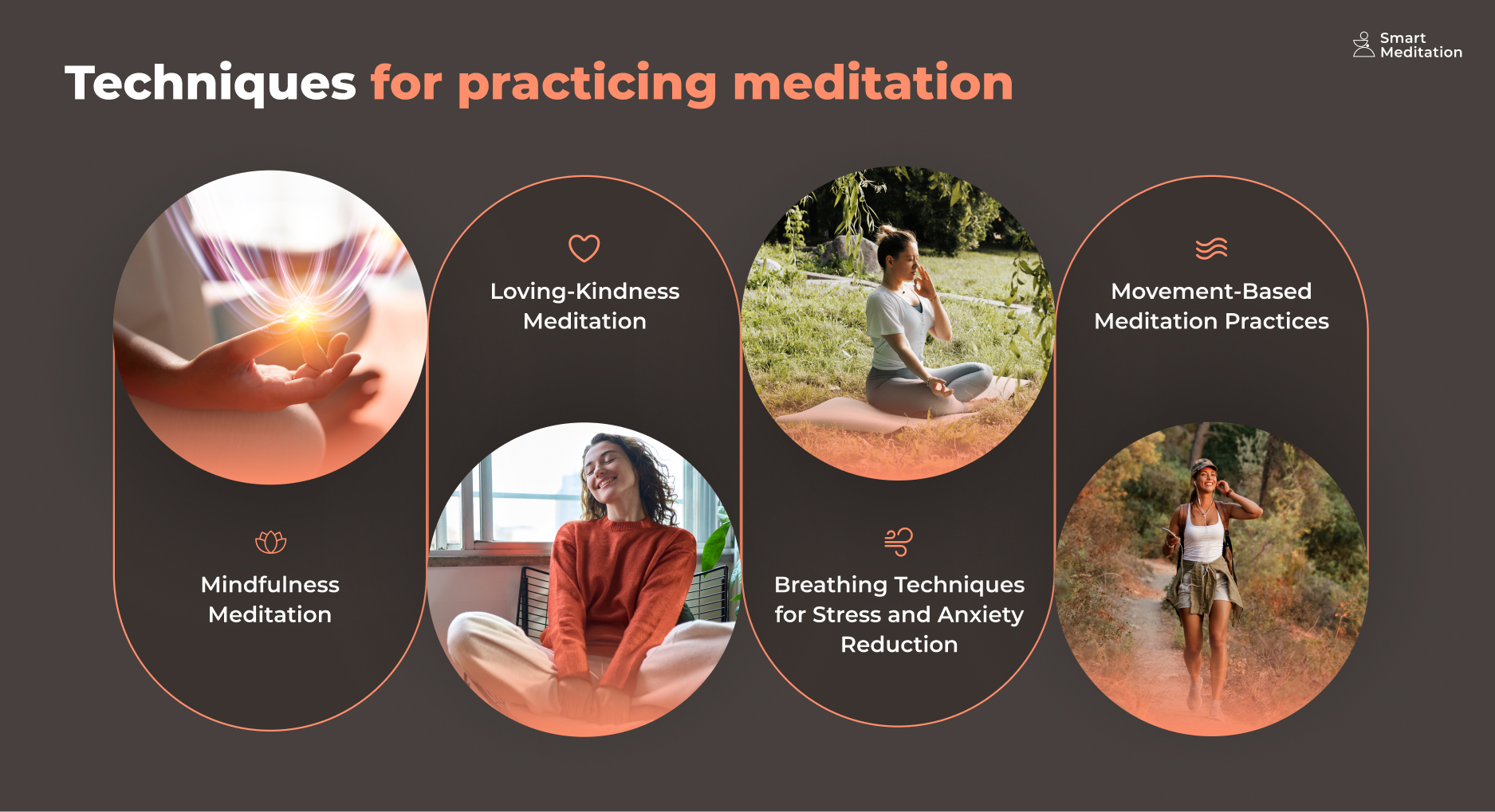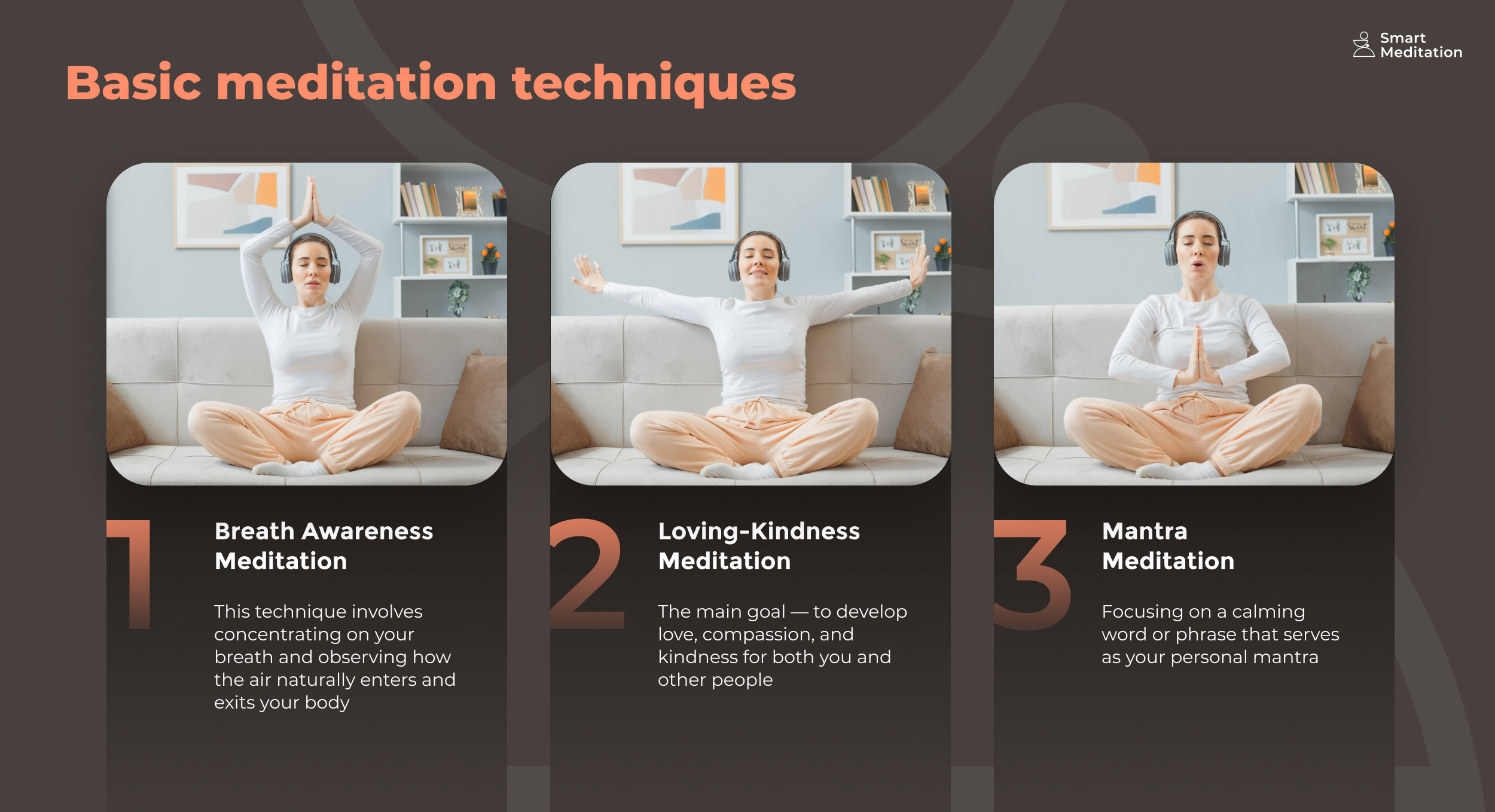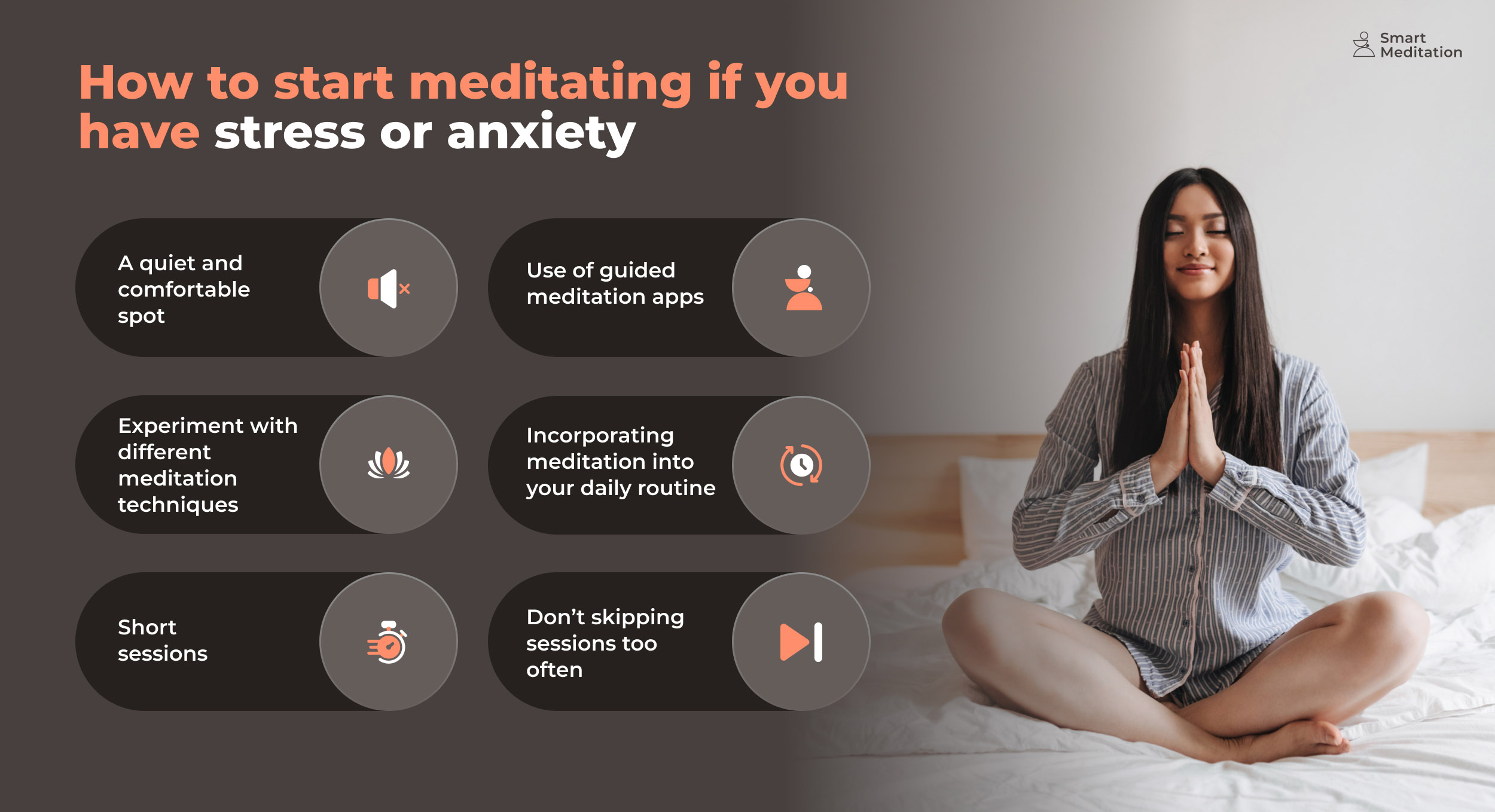
Meditation: A Powerful Tool for Reducing Stress and Anxiety
For better or worse, stress and anxiety are completely normal and natural parts of our life. Some people are able to embrace the stress and make it boost their performance, while others may get slightly overwhelmed with negative thoughts and it is also completely normal.
And if you are looking for an easy and cheap way of reducing your stress levels, look no further than anxiety relief meditation. In this article, we’ll be looking at how meditation for stress relief can help anxiety disorders, how it impacts our mind and body, what meditation techniques and types there are, and, finally, give you some tips on how to start meditating.
The Significance of Stress and Anxiety Reduction
Stress reduction is a common theme when it comes to treating a wide range of anxiety-related disorders. We’ve already covered in depth which specific meditation types are best for specific disorders; here we’d like to give a summary of what anxiety disorder meditation can offer:
- Generalized Anxiety Disorder (GAD), for instance, can be helped by meditation through fostering the ability to disengage from anxiety-provoking thoughts. Meditation also helps develop environmental awareness, better cope with physical tension, and better control your thought patterns.
- Social Anxiety Disorder (SAD) can be relieved with body scan meditations – it helps you discover your body and mind and teaches you to be in harmony with yourself and your environment, social or otherwise.
- Obsessive Compulsive Disorder can be treated with mantra meditation – obsessive thoughts and compulsive behaviors are easier to control when you teach yourself to be able to focus on just one specific thing, a mantra that you repeat to yourself aloud.
The Science Behind Meditation and Stress Reduction
In the last couple of decades, we’ve seen more and more attention to meditation coming from scientists. Research on the benefits of meditation is becoming more and more popular, and a lot of it we’ve covered in one of our previous articles. Here, let’s take a look at some of the benefits most commonly associated with meditating:
Neurological Impact of Meditation on the Brain
Stress relief meditation practice is known to have positive effects on the development of our brain. It can impact such brain parts as the prefrontal cortex and amygdala, which are important in processing emotions and controlling stress. Meditation improves the neural connections in the prefrontal cortex, which is supposed to help with emotion regulation, and decreases amygdala’s sensitivity, making the brain’s responses to stress milder. In general, meditation improves our capacity for efficient stress management and develops a sense of wellbeing.
The Stress Response and Meditation
At surface level, anxiety relief meditation makes our breathing more relaxed, and stabilizes our blood pressure and pulse. But looking into it deeper, these physiological changes denote a change from the sympathetic nervous system’s “fight-or-flight” mode to the parasympathetic nervous system’s “rest-and-digest” mode, which is a big positive when fighting anxiety. Meditation develops a sense of peace and equilibrium in oneself, which in turn helps to reduce the production of stress hormones like cortisol.
Psychological Benefits of Meditation for Stress and Anxiety
Regular practice increases self-awareness and cultivates an accepting and nonjudgmental mindset toward our thoughts and feelings. That is because, In meditation, we observe our sensations without getting sucked into them, which gives us a feeling of perspective and harmony not only with ourselves, but also with the outer world. It also fosters mental sharpness and emotional fortitude, enabling us to better deal with challenges and control anxiety.
Techniques for Practicing Meditation
We’ve already covered a wide range of the best meditations for anxiety. In this section here, we’ll only touch upon the very basics – the most common and the easiest to pick up techniques:

Mindfulness Meditation
The main goal of mindfulness meditation is to focus entirely on the present moment. With this method, you can learn to track and acknowledge your thoughts, emotions, and bodily sensations without passing judgment on them. Begin by concentrating on your breathing and observing how each inhalation and exhalation feels. Then you can broaden your awareness so it includes the rest of your body and even your surroundings and our physical body.
Loving-Kindness Meditation
Loving-kindness is a meditation for stress relief that fosters feelings of kindness and love for both oneself and others. You start by recognising that you are worthy of love and happiness and sending yourself good thoughts and wishes. You can then extend these wishes to your family and friends.
Breathing Techniques for Stress and Anxiety Reduction
The simple practice of deep diaphragmatic breathing, also known as belly breathing, enables us to trigger our bodies’ relaxation response. For that, you’ll need to take long, deep breaths, letting your belly rise and fall naturally with each breath.
Another great breathing exercise is the 4-7-8 technique. It involves taking a deep breath in for four seconds, holding it for seven, then gently exhaling for eight. This kind of controlled and timed breathing helps regain inner tranquility and achieve harmony with yourself.
Movement-Based Meditation Practices
Not everyone knows that meditation doesn’t have to be static. Movement-based meditation techniques encourage us to be more dynamic while still being aware of our surroundings. One such technique is walking meditation – you simply go out and start casually strolling. Focus on the way your feet feel on the earth, the beat of your steps, and the sights and noises all around you as you stroll.
Other kinds of movement-based meditation feature movements timed with the breath – some examples of these are yoga, tai chi, and qigong. Through fostering a strong bond between the mind and body, these activities develop a holistic approach to well-being that encourages relaxation and harmony.
Different Types of Meditations for Stress and Anxiety
Naturally, meditation isn’t limited to the techniques described above – there are many more. In this section we’ll look at the slightly broader classification of meditation for anxiety types, talking not about specific exercises (which are covered here in detail), but more general approaches:
Mantra-Focused Meditation
Mantra meditation is a type of meditation where you repeat a mantra (a sound, a word, or even a phrase) to focus your mind on a singular thing and feel inner peace and clarity. Repetition of the mantra serves as a focal point that diverts attention from wandering thoughts. You can use different mantras, depending on your preferences or the particular tradition you can choose to adhere to. Some of the most widely used ones are “Om”, “Om Namah Shivaya”, and “Sat Nam.”
Body Scan Meditation
Body scan meditation is a stress relief meditation that requires you to concentrate on each of your body parts. It’s often used to calm your body and help you become more aware of your environment. You can begin by sitting or standing comfortably while listening to pleasant instrumental music. Then, tell yourself to focus first on your head and how it feels right now, then move your attention to your neck, then shoulders and so on.
Guided Meditation
If you’re learning how to perform anxiety relief meditation from scratch, guided meditation is arguably the best option (which we’ve talked about extensively in this article). Guided meditation is practically any meditation practice that is assisted by a third party. For a start, you can try out online meditation assistance – YouTube videos, podcasts, audio tracks are all solid picks choices. You can also go for an in-person meditation experience and take part in guided meditation sessions like yoga.

How to Start Meditating if You Have Stress or Anxiety
Here are some quick beginner tips to make the most out of your first steps into anxiety relief meditation:
- Find yourself a quiet and comfortable spot where you can meditate without being bothered;
- Don’t be afraid to experiment with different meditation techniques – it takes most people some time to organize their session in the best possible way;
- Don’t go too hard on yourself – begin your practice with short sessions and then gradually extend them at your own pace;
- Make use of guided meditation apps to help you stay motivated and enrich your meditation experience (we’ve talked about how to choose the best meditation app here);
- Try Incorporating meditation into your daily routine – connect your sessions with a pleasant thing that you do every day (eat, sleep, etc.);
- Remember that the biggest challenge in meditation is staying consistent – make sure that you’re not skipping sessions too often.

Seeking Professional Help: Meditation as a Complementary Approach
As helpful as meditation can be for relieving anxiety, it’s important to know that it shouldn’t be a full substitute for professional mental health treatment. Here’s what you need to know about combining the two for the best effect:
The Role of Mental Health Professionals in Stress and Anxiety Treatment
Mental health specialists such as therapists and counselors should be your number one choice if you feel that your anxiety is overwhelming. They can create an environment that is safe and encouraging enough for you to honestly explore your feelings, ideas, and experiences. They also offer evidence-based therapeutic strategies that are specialized to meet your needs and support your growth, healing, and creation of potent coping mechanisms. It’s crucial to have expert assistance that addresses the underlying causes of discomfort even if you do meditation regularly.
Collaborating with Therapists and Counselors
The great thing about stress relief meditation is that it doesn’t have to be “either or”. It’s often very beneficial to work together with your therapist on including meditation in your stress and anxiety treatment plan. Therapists are typically well-qualified and experienced enough to provide individual advice on the best meditation practices based on your specific needs. The main problem usually arises where there isn’t enough openness between you and your therapist; for instance, you may be afraid of letting your therapist know that you practice meditation. Remember that it’s vital to not be ashamed or fearful to tell them everything they need to know to help you.
How Meditation Can Enhance Traditional Therapy
Meditation, along with traditional therapy, can cultivate self-awareness, emotional fortitude, and a more positive outlook on life in general. They also help you deepen your self-reflection and better understand your own feelings and thoughts. And finally, they are great for learning how to control your emotions and spend less time overthinking or overanalyzing your life experiences.
Conclusion
Meditation for stress relief is a great practice that helps one live a better, brighter life. It helps with many anxiety disorders such as GAD, SAD and OCD and makes our body and brain be more resilient to incoming stress. Some of the most common anxiety disorder meditation techniques and types are mindfulness meditation, breathing meditation, mantra meditation and loving-kindness meditation. It’s also a good idea to try out guided meditation for an overall richer experience – you can do it with the help of a guided meditation app like Smart Meditation.
Remember that meditation is not a full substitute for professional treatment, so if your anxiety is overwhelming, immediately contact a mental health professional. An experienced specialist will enable you to have the best of both worlds by smartly combining traditional treatment with your meditation practice.






